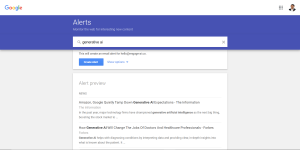AI language models have aided in various tasks, including artwork creation, email, and article composition, consumer trend prediction, and email composition. Today, we’ll look at OpenAI’s ChatGPT 4, also known as GPT-4, the most recent and cutting-edge advancement in artificial intelligence language models.
OpenAI ChatGPT 4, also known as GPT-4, has emerged as the clear leader due to a slew of new features and enhancements over its predecessor, GPT-3.5. This comprehensive guide will discuss how to use GPT-4, its new features and availability, and address some user concerns raised since the product’s inception.
How to Use ChatGPT 4
The user experience with ChatGPT 4 is designed to be straightforward and user-friendly. It functions as a plug-and-play model that requires minimal setup.
Setup and Initialization
To use ChatGPT 4, you’ll need to access the OpenAI API. The API can be accessed by integrating the OpenAI library into your Python application. After importing the OpenAI library, create an instance of the chat model and then utilize it with the chat completion method. You can then provide a list of messages as input to initiate a conversation.
Holding a Conversation
The strength of ChatGPT 4 lies in its conversation capabilities. You can get detailed and contextually accurate responses by feeding the model with messages as in a chat conversation. Messages in the list can be from a user, an assistant, or a system. With this format, ChatGPT 4 allows for a highly interactive and dynamic conversational flow.
What’s New in GPT-4?

GPT-4, developed by OpenAI, has leaped forward from its previous version, ChatGPT 3.5. This generative pre-trained transformer model, known for emulating human-like text, now boasts enhanced creativity, visual input, and extended context capabilities. This means the new AI model can interact more creatively with users and understand and generate content based on a user’s writing style.
1. Visual Inputs
One of the major advancements in GPT-4 is the introduction of visual input. This feature allows ChatGPT 4 to interact with images, not just text, marking a significant step towards a more interactive AI experience. However, its deployment has been delayed due to safety challenges. You can experience this feature with Bing Chat or MiniGPT-4, an open-source project developed by Ph.D. students, albeit at a slower pace.
2. Enhanced Performance
GPT-4’s performance on exams such as the SAT and Advanced Placement-level tests has been impressive. It scored in the top 10% on a simulated bar exam and significantly improved over GPT-3.5 in SAT reading, writing, and math exams. Despite some weaknesses, the improvements indicate the model’s growing capabilities.
3. Steerability
The ‘steerability’ of GPT-4 has been greatly enhanced, allowing users to prescribe the AI’s style and task with ‘system’ messages. This means GPT-4 can alter its behavior based on user commands, thus providing a more tailored interaction.
4. Enhanced Understanding
One of the most noticeable improvements in ChatGPT 4 is its refined comprehension and ability to understand the context. The model has been trained on an expansive corpus of text, resulting in its deep understanding of various topics. This improved comprehension ability enables the model to handle complex conversations and provide more nuanced and contextual responses.
5. Improved Interactivity
Another significant upgrade in GPT-4 is its improved interactivity. The model can easily handle back-and-forth conversations, making it more dynamic and interactive. It can maintain longer conversation threads, keep better track of context, and even recall previous messages in the conversation more accurately.
6. Inference Speed
Despite the massive model size and the new features, GPT-4 maintains a competitive inference speed. This speed is essential for cases requiring real-time responses, such as chatbots, virtual assistants, and more.
Availability of ChatGPT 4
ChatGPT 4 is provided as a cloud-based service by OpenAI. The API is publicly available for developers and organizations that wish to integrate the power of GPT-4 into their systems or applications. While there is a cost associated with using the API, OpenAI also provides free usage tiers to ensure accessibility for a broader user base.
Best GPT-4 plugins
The GPT-4 plugin suite has undoubtedly provided the most exciting platform enhancements. Plugins, such as the code interpreter and web browser plugins, allow developers to significantly extend GPT-4’s capabilities, allowing it to perform a wide range of tasks.
1. ChatGPT Code Interpreter
The ChatGPT Code Interpreter is changing the way developers code. This revolutionary plugin lets you use Python in a persistent session, greatly simplifying coding. GPT-4 can execute Python code across user turns in a conversational context. The code interpreter can handle Uploads and downloads, expanding data management and analysis options.
Developers have an infinite number of practical applications. AI is capable of debugging, writing, and teaching programming. Because of its intuitive Python understanding, it is a powerful tool for both beginners and experts.
For non-developers aiming to optimize their applications, leveraging python development services can be a strategic decision.
2. Web Browser Plugin
The web browser plugin is another excellent GPT-4 tool. The plugin grants GPT-4 complete web access, allowing the AI model to overcome its limitations and obtain real-time data from the internet. GPT-4 allows users to find current information on a variety of topics.
Consider this: A breaking news story or financial report requires up-to-date information. With the web browser plugin, GPT-4 can provide real-time data at internet speed as a research assistant. It extends GPT-4’s knowledge beyond the training cut-off date 2021, filling the knowledge gap and increasing its usefulness.
3. Other Notable Plugins: Zapier, Wolfram, Engage AI, and Speak
Zapier, Wolfram, Engage AI and Speak are four other plugins that bring additional functionalities to GPT-4.
GPT-4 is more productive and integrated thanks to Zapier, a popular web application workflow automation tool. GPT-4 can use Zapier to automate repetitive tasks, trigger workflows, and connect to other apps.
The Wolfram plugin, on the other hand, excels at data analysis and computation. Wolfram’s powerful capabilities in these areas enable GPT-4 to perform seamless calculations, providing users with a powerful computational companion.
The Engage AI Hashtag Analytics plugin revolutionizes LinkedIn networking. Engage AI is powered by GPT-4 and can be utilized to retrieve hashtag follower counts, trends & suggestions to increase your content reach on LinkedIn.
Finally, the Speak plugin for GPT-4 adds voice commands and conversations. As a result, GPT-4 is suitable for use in voice-activated systems, smart devices, and other natural language processing applications.
And More: The Future of GPT-4

While GPT-4 is already proving its mettle, the future looks even brighter. As we continue to witness rapid advancements in AI, there is no doubt that ChatGPT 4 and its successors will continue to evolve, offering even more sophisticated features and capabilities.
In the coming years, we can expect the model to understand better and generate human-like text, understand more languages, and even excel in tasks beyond language understanding. To stay ahead of the curve, businesses are racing to adopt and leverage AI capabilities, including ChatGPT integration. By embracing advanced conversational AI, they can level the playing field and enhance their digital strategies.
Takeaway
ChatGPT 4 is a powerful tool that significantly improves AI language comprehension. Because of its accessibility, innovation, and usability, it is a valuable resource for businesses and software engineers. As we move into an AI-enhanced future, GPT-4 exemplifies language model advancements and their disruptive potential in various fields.
GPT-4 is a step forward rather than a radical departure from the status quo. While acknowledging that AGI (artificial general intelligence) can potentially disrupt global economies, OpenAI CEO Sam Altman advocates for incremental improvements rather than revolutionary breakthroughs. Despite these reservations, GPT-4 will become essential to future language model advancements.
Despite a few reported inconsistencies, GPT-4, also known as ChatGPT 4, significantly improved over its predecessors. Its improved properties pave the way for novel AI interactions and promising advancements in AI-powered language models.








